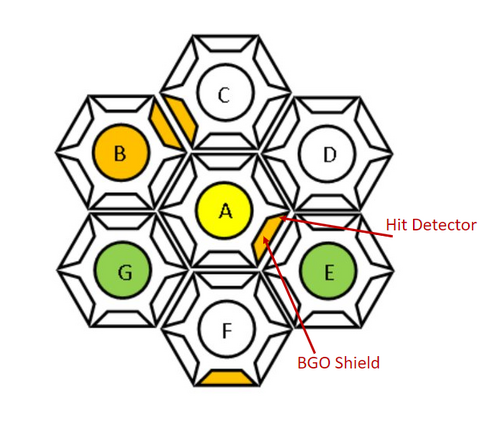Detector Signals
Gammasphere detectors give data back through specific signals. The main signals are called GeCenter, GeSides, BGOSum, and now, after upgrades, BGOPatterns. These signals are defined by the way gamma-rays hit different parts of the HPGe inside a detector. The different points where the HPGe can be hit are called "contact points".
GeCenter
The germanium inside each detector is a cylindrical shape with a hole through its center. It becomes a contact point known as the "GeCenter".
GeSides
GeSides are another contact point of the germanium. They entail the germanium around the hole in the center. There are two types of germanium placed in the detector: segmented and non-segmented. Segmented germanium has an insulator in the middle of its cylindrical shape (thus making two sides or halves), while non-segmented germanium is not split by anything. The two types of detectors are not treated very differently, but based on the type of germanium there are varying electronics used to receive data.
BGOSum
In addition to HPGe, Gammasphere's detectors use BGO, or bismuth germanium oxide to absorb gamma-rays. The BGO surrounds each Gammasphere detector in a hexagonal shape. The BGO sum signal is the sum of hits to the sides of a detector's BGO.
BGOPattern
The BGOPattern channel of the SBX uses two ranks of analog switch plus a set of discriminators to generate a wide variety of signal possibilities.
Clean/Dirty Events
Should the gamma-ray scatter within the Ge portion of the detector, the scatter will normally be detected by interaction with the BGO shields. Thus we define a 'clean' event as one that excites the Ge but none of the surrounding BGO of a given detector and a 'dirty' event as one in which both the Ge and BGO light up. Within the digitizing data acquisition system, the sum of all 7 BGO signals is applied to one digitizer channel and the Ge center contact is digitized by another channel in the same digitizer. A discriminator threshold is applied to both signals and the Router trigger module looks at the time relationship between Ge discriminator bits and the associated BGO Sum discriminator bits. If the two discriminator bits are close enough in time the event is marked as 'dirty'.
Electric Honeycomb
The Electric Honeycomb concept is an intended function of the BGO Pattern signal path to provide information regarding cross-detector scattering to the trigger. It was implemented for better suppression of Compton-scattered events, in which the fast discriminator bits from the 7 BGO segments of each detector (six shields plus back plug), plus the six individual BGO discriminator bits that are face-to-face with the BGO shields, be combined. Figure 1 to the right demonstrates this concept, with detector A (the detector hit by a gamma ray) being paired with its surrounding detectors for data acquisition in order to suppress the scattering.
